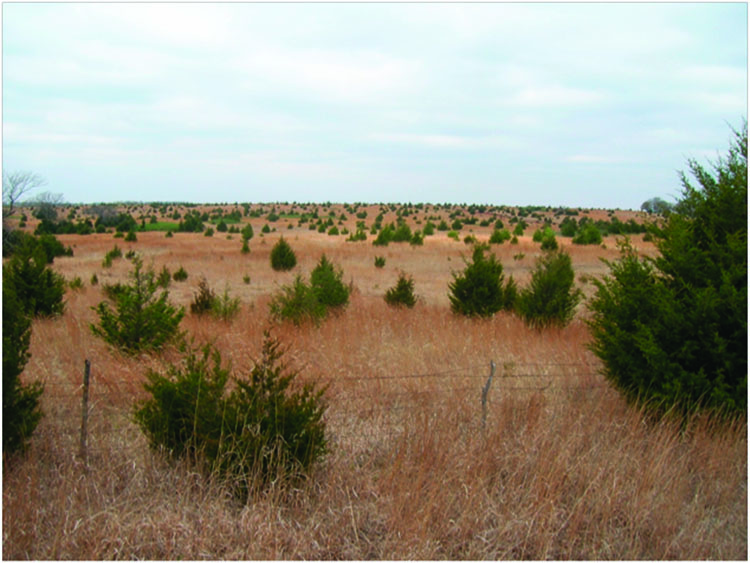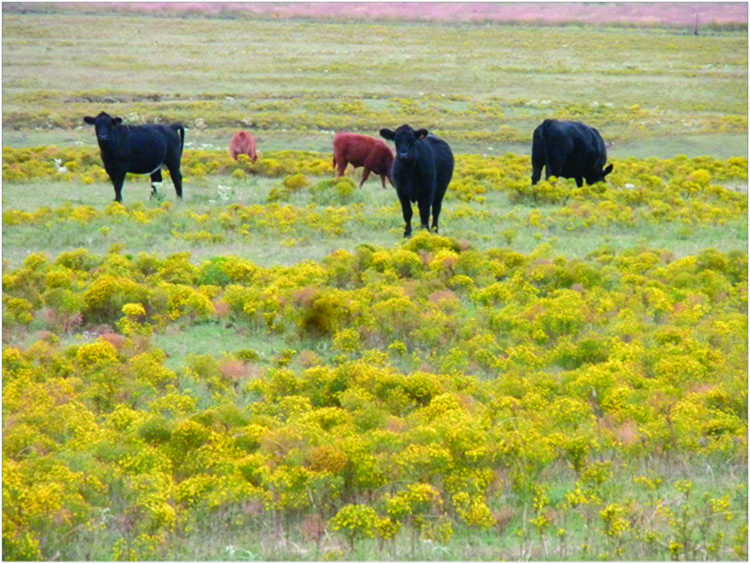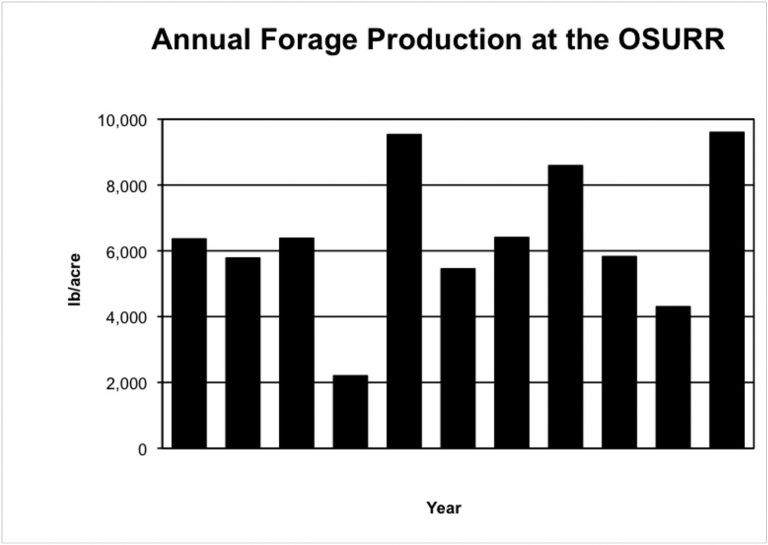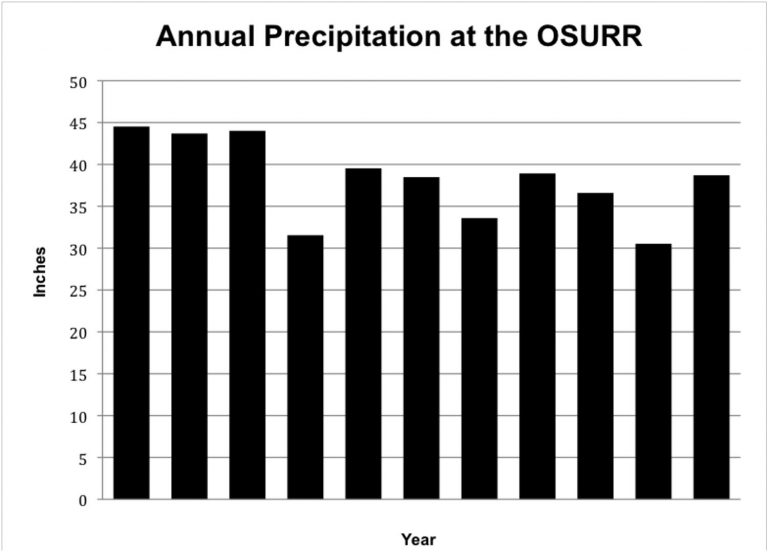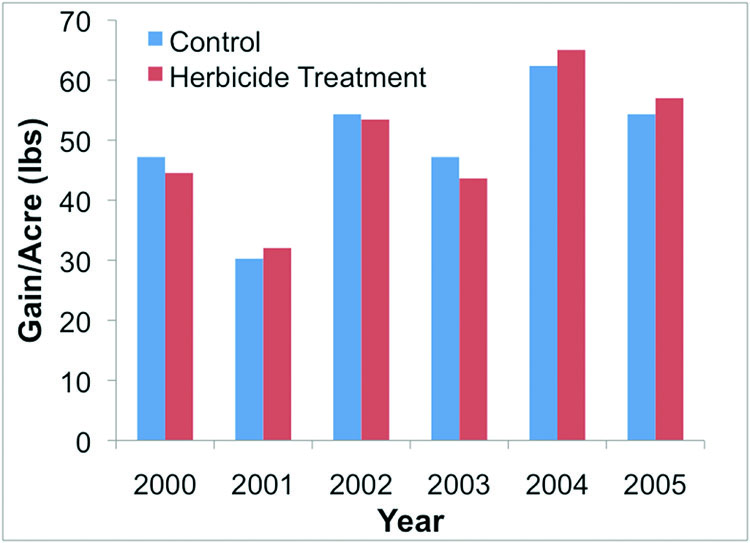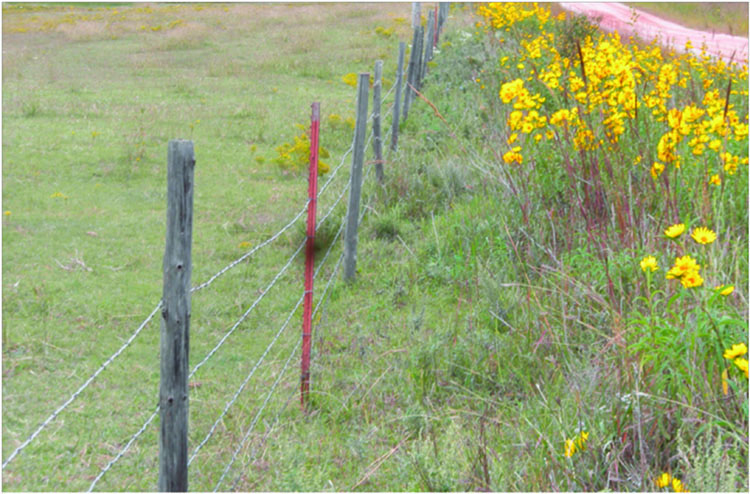Weed Control on Rangelands
Every year thousands of acres of native prairie, shrubland, and forest in Oklahoma are sprayed with herbicide to control weeds to benefit livestock production. This practice is expensive and not often profitable when viewed in the light of potential marginal increase in income from livestock production. Additionally, this practice can have serious impacts on other land uses and landowner objectives such as management of wildlife habitat. Herbicides also kill many plants that are valuable to livestock production since they do not discriminate between desirable and undesirable plants. To make sound land management decisions, landowners need to understand the costs and benefits of spraying weeds.
The term weed is commonly used in reference to any undesirable plant or a plant that is out-of-place. In native habitats–prairies, shrublands, and forests–weeds can be introduced plants (i.e. non-native) or native plants, such as eastern redcedar (Juniperus virginiana), that have spread into the area because of poor land management (Figure 1).
In fact, a weed can be any kind of plant (a grass, forb, shrub, or tree). Examples of introduced, non-native plants that are weeds in native habitats throughout Oklahoma are sericea lespedeza (Lespedeza cuneata), salt cedar (Tamarix spp.), Bermudagrass (Cynodon dactylon), Old World bluestems (Bothriochloa ischaemum), tall fescue (Lolium arundinaceum), and Johnsongrass (Sorghum halepense). To determine if native plants that should or should not occur on a specific site, land managers can refer to the USDA Natural Resources Conservation Service (NRCS) Ecological Site Descriptions. These detailed ecological site descriptions can be found at https://www.nrcs.usda.gov/wps/portal/nrcs/main/national/technical/ecoscience/desc/
The term weed is sometimes used to describe a whole group of plants known as forbs. Forbs are any herbaceous plant other than members of the grass, sedge, or rush family. Forbs are dicots and usually have broad leaves and brightly colored flowers. Labeling all forbs as weeds is erroneous because most of these plants provide benefit to either livestock or wildlife (Table 1), and removing these plants from an area can limit production potential.
Some land managers use herbicides to control weeds for aesthetic reasons, believing that the native plant community should look like a lawn or an introduced forage monoculture. This perception might reflect equating the reduction in weeds to an increase in livestock production. However, the correct question to ask about weed control before any action is taken should be: “Are these plants detrimental to my management goals?” The answer to this question should be based on objective facts, rather than on cultural attitudes and beliefs. Abundant populations of some plants, including grasses, forbs, and woody plants, can result from changes in weather patterns (such as a wetter than normal autumn) or poor management. Large amounts of forbs found in one year due to weather are not unusual, and the forbs often decrease in abundance the next year. However, large amounts of forbs that occur following poor grazing management will not be resolved without reducing the stocking rate to match the production potential of the site (Figure 2).
Figure 1. Even though it is a native plant, eastern redcedar can be considered a weed because it invades grasslands, shrublands, and forests throughout our state that are not being properly managed.
Figure 2. Abundant populations of some plants can result from changes in weather patterns or poor management. Large amounts of forbs found in one year due to weather are not unusual, and the forbs normally decrease in abundance the next year. However, large amounts of forbs that occur following poor grazing management will not be resolved without reducing the stocking rate to match the production of the site.
Table 1. Examples of Oklahoma plants commonly considered weeds that provide wildlife benefit and are desirable cattle forage plants.1
| Plant | Cattle | Northern Bobwhite | White-tailed Deer |
|---|---|---|---|
| Common Yarrow | X | X | |
| Lambsquarters | X | X | X |
| Englemann’s Daisy | X | X | X |
| Annual Sunflower | X | X | X |
| Prairie Phlox | X | X | |
| Compass Plant | X | X | X |
| Maximilian Sunflower | X | X | X |
| Pokeweed | X | X | X |
| Virginia Creeper | X | X | X |
| Elderberry | X | X | X |
| Greenbrier | X | X | X |
| Muscadine | X | X | X |
| Willow | X | X | X |
| Winged Elm | X | X | X |
| False Indigo | X | X | X |
Understanding Forb Production
Plant growth fluctuates with the amount and distribution of precipitation (Figures 3 and 4). With this variation in precipitation, production and species composition of the forb community fluctuates. In some years there are large populations of annual forbs, while the next year there may not be any present. For example, dry years produce bare ground, which is required for common broomweed (Gutierrezia dracunculoides) to germinate, so this forb flourishes in wet years following dry years. Bare ground can also result from overutilization by livestock or other soil disturbances. In years with average or above average precipitation, common broomweed is seldom abundant except in heavily grazed areas (e.g. watering points, feed grounds, etc.). This climatic variation makes weed control unnecessary because the plant community shifts without chemical intervention. Due to the fluctuation of precipitation, chemical weed control would not yield any benefit by controlling annual forbs that are abundant one year and disappear the next.
Figure 3. Forage production from a tallgrass prairie site on the OSU Research Range near Stillwater averaged 6,360 lbs/acre during an 11-year period, but production fluctuated yearly from 2,000 to more than 9,000 lbs/acre.
Figure 4. Average annual precipitation for the period referenced in Figure 3. Notice the relationship of the forage production in Figure 3 to that same year’s precipitation amount.
Does Spraying for Weeds Pay?
The old saying “a pound of grass for a pound of weeds” has always brought visions of increased cattle production to ranchers, but is this saying based on objective fact or just folklore? Does spraying weeds translate into increased beef production or increased profits? Herbicide research by-and-large has not addressed cattle gain or cost-to-benefit ratio. Most herbicide research on grazing lands has been conducted on small, ungrazed plots in which plant response is measured, these are called efficacy studies. Some small plot studies have shown an increase in grass production following the treatment of forbs with herbicide. However, in other small plot studies, reducing forbs with herbicide did not increase forage grasses. This was especially true when forbs were not dense and perennial grasses were not abundant, such as during low precipitation years. However, plant response does not necessarily translate to cattle production. In contrast to small-plot research, pasture-level research is more meaningful to a producer since it is the bottom line that counts. To date, research conducted on native plant communities has documented no increase in livestock production following herbicide application for the control of forbs. Thus, the assumption that an increase in grass forage on small plots following herbicide application can be scaled upward into increased livestock production should be viewed with skepticism.
A specific example for Oklahoma is research conducted by Oklahoma State University at the Marvin Klemme Range Research Station located near Bessie, OK to determine the effects of herbicide on livestock performance2. This study found no improvement of livestock average daily gain (Figure 5) or gain per acre (Figure 6) with the application of herbicide to control weeds. Thus, the cost of the herbicide was added to the cost of operation since there was no increase in cattle production. Producers could easily replicate this study on their properties to find out if herbicide application improves profitability.
Figure 5. The average daily gain of stocker cattle on the Marvin Klemme Range Research Station located near Bessie, Oklahoma. Herbicide was applied in April 2001 and May 2004 to the herbicide treatment pastures. Stocker cattle average daily gain did not differ between the no herbicide control pastures and the herbicide treatment pastures2.
Figure 6. The gain per acre of stocker cattle on the Marvin Klemme Range Research Station. Herbicide was applied to the herbicide treatment pastures in April 2001 and May 2004. Gain did not differ between the no herbicide control pastures and the herbicide treatment pastures. Gain varied primarily with growing season precipitation, which reflects annual variation in forage production2.
Are Weeds Really That Bad?
Given a choice, cattle ordinarily select a diverse diet of grasses, sedges, forbs, legumes, and woody plants. Studies across the US show that the total amount of forbs consumed in cattle diets varies from 20 to 30 percent, depending upon availability3. Many forbs have a higher nutritional value than grasses, even though forbs make up a small percentage of the total cattle diet. Therefore, herbicide application will reduce some of the most nutritionally valuable forage plants for livestock production—forbs.
Let’s compare the nutritional value of a common grass with a forb: crude protein in big bluestem (Andropogon gerardii) peaks at 10 percent in May and then declines to 9 percent by the end of summer (Table 2). In contrast, Illinois bundleflower (Desmanthus illinoensis), a native legume easily killed by broadleaf herbicides, which is also readily eaten by livestock, has a crude protein content of 35 percent in April and 13 percent at the end of summer (Table 2). Western ragweed (Ambrosia psilostachya) is one of the most commonly sprayed forbs in Oklahoma, is consumed by cattle when young, and is one of the most important fall and winter foods for Northern Bobwhite quail. Western ragweed has a crude protein level more than 20 percent in May and about 15 percent in the fall (Table 2). Research in Kansas6 and Oklahoma7 has shown that western ragweed does not compete with grass, so controlling it by applying herbicide does not yield more grass (for more information see OSU Extension publication NREM-2873 Ecology and Management of Western Ragweed on Rangeland). Consider this tradeoff–the cost of a pound of 20 percent protein cubes compared to the cost of spraying herbicide on plants that have more than 30 percent crude protein and are readily consumed by livestock. In fact, many broadleaf plants enhance quality of cattle and wildlife diets without the cost of supplements.
The USDA-NRCS Ecological Site Descriptions are useful tools to examine the value of plants within a pasture. For example, in a healthy shallow savanna site, common in the Cross Timbers, you should find a total of 42 different plant species, which includes 14 species of grasses, 12 species of forbs, 11 species of shrubs and 5 species of trees. Of these plant species, livestock prefer 11 species of grass, 9 species of forbs, 5 species of shrub, and 1 species of tree. So, of the 42 total species known in the site, 26 are an important part of cattle diets. However, of these preferred plants, 15 are killed by broad-leaf herbicides, and 9 of those 15 have more nutritive value than grasses. Using herbicide to kill forbs might reduce the amount of perceived weeds, but it will also reduce the amount of high quality forage (forbs) available to the grazing animal.
Table 2. Crude protein content during different times of the year of selected plants that are preferred by livestock and wildlife.
| Plant Species | April | May | June | July |
|---|---|---|---|---|
| Big Bluestem4 | - | 10.2 | 8.2 | 7.3 |
| Little Bluestem4 | - | 8 | 6.5 | 6.9 |
| Greenbriar5 | 26.1 | 14.6 | 11.3 | 10.2 |
| Western Ragweed5 | 28.2 | 20.5 | 18.7 | 13 |
| Illinois Bundleflower5 | 35.1 | 26.2 | 22.9 | 22.4 |
| Showy Partridge Pea5 | - | - | 20.9 | 20.4 |
| Plant Species | August | September | October | November |
|---|---|---|---|---|
| Big Bluestem4 | 9.2 | 9 | - | - |
| Little Bluestem4 | 6.5 | 6.3 | - | - |
| Greenbriar5 | 8.9 | 8.9 | 9.3 | 10.9 |
| Western Ragweed5 | 11.6 | 13.2 | 12.9 | 16.4 |
| Illinois Bundleflower5 | 13.6 | - | - | - |
| Showy Partridge Pea5 | 18 | 15.4 | 14.7 | - |
When to Spray
Spot spraying or selectively targeting invasive plants can be effective in treating targeted species (true weeds or invasive) without harming other plants. Almost all approved herbicides have spot treatment recommendations on the product label. When using any herbicide, read and follow the label recommendations.
Broadcast application of herbicide to remove forbs from the landscape has not been shown to improve livestock gains as mentioned earlier. Herbicides will remove preferred and high quality livestock forage, important wildlife foods and cover, and may well reduce net income from livestock and recreational leasing. If a weed problem is so extensive that spot spraying is not practical, then understanding the biology of the targeted plant species can provide important insight into managing the plant. Finally, the manager should consider if controlling the plant will meet management objectives including cost-benefit ratio. Using an example of $10 per acre herbicide and application cost with stocker cattle stocked at 4 acres per head, the break-even requires cattle to gain a $40 per head margin over a no-herbicide option. On the other hand, if you have a cow/calf operation and are stocked at 15 acres per cow the herbicide application will cost an added $150 per animal. In both examples, it is very unlikely that break-even cost of herbicide use will ever be met.
The “weeds” are always greener on the other side of the fence.
At first glance of the picture below many cattlemen may consider the sunflower plants in the ditch a weed. However, these are Maximilian sunflower (Helianthus maximilianii), which is a highly nutritious and palatable forb that is readily eaten by wildlife and livestock. Note that they are absent in the pasture (left side of photo), as well as in the ditch as far as the cattle can reach through the fence. There was no herbicide applied here, this is all due to the impact of grazing. Livestock consume more weeds than most people realize, and more often these weeds are more nutritious than the available grasses.
Alternatives to Spraying
More effective and economical alternatives to herbicides deserve consideration. For example, prescribed fire can accomplish many objectives of land owners, and an economic analysis of burning clearly shows break-even is usually exceeded. Many plant species that are targeted with broadcast applications of herbicide are woody plants that can be managed with prescribed fire. Burning improves livestock performance by increasing stocker cattle gain by 10 percent to 15 percent and increasing the body condition score of cows. It also increases forage quality, palatability, and benefits wildlife habitat.
Another alternative is patch burning (rotational fire with grazing) which has been shown to reduce or stop the increase of several invasive plant species such as sericea lespedeza8 (Figure 7). (For more information on patch burning see OSU Extension Publication E-998 Patch Burning: Integrating Fire and Grazing to Promote Heterogeneity). Stocking browsing animals, such as goats, can also be very effective at controlling woody plants.
Figure 7. Annual invasion of sericea lespedeza within patch burning and traditional grazing management practices. Patch burning suppresses the sericea lespedeza invasion while the traditional grazing management allows the invasion to occur at roughly a 2 percent increase in cover per year, four times that which is seen in the patch burn treatment8.
Herbicide Effects on Wildlife
The primary effects of herbicide on wildlife are the negative impacts to wildlife habitat—to plant species composition (i.e. the species of plants and their abundance) and to vegetation structure (i.e. the value of the plants for cover). Therefore, killing most forbs with herbicide is detrimental to many wildlife species. Often, a single plant species provides multiple benefits to an animal or it can benefit numerous types of animals (Table 1). Because wildlife requires a diverse community of native plants, broadcast herbicide application to control forbs and shrubs decreases habitat diversity and limits food resources. If wildlife is a goal, landowners should carefully consider any herbicide application.
Summary
The information in this Fact Sheet should not be taken to mean that herbicide application is always an improper tool for managing weeds. A weed is an undesirable plant and Oklahoma has some serious introduced weed problems, so herbicides are sometimes the best management tool. We encourage land managers to learn to identify and understand the plants they manage to determine if controlling those plants with herbicides will accomplish management objectives (for plant identification information see references at the end of the publication). Weed control with herbicides on native rangelands, shrublands, and forests is often not only detrimental to wildlife habitat, but a misuse of time and money from a cattle production standpoint. Thus, even if management goals are associated only with livestock production, the cost-benefit ratio of weed control should be evaluated. Cost often exceeds economic benefit and herbicide application often degrades wildlife habitat, so managers should assess herbicide application.
Test the Cost Benefit on Your Own
To examine the benefit of herbicide application in your production situation, take one of your pastures that you normally spray for weed control. Split the pasture in half equally with an electric fence, making sure that the production potential is the same on both sides. Spray one side of the pasture like you normally would and leave the other side untreated. Apply the proper stocking rate, equal on both sides, with stocker cattle or replacement heifers. Young, non-reproductive cattle provide the best test, since weight gain can be easily measured. The cattle need to be weighed before being placed on the pasture and then weighed when they come off. Compare the results. Ranchers are often surprised to find that spraying weeds fails to increase cattle gain. Even if there is a slight increase in cattle gain, you should determine if the extra income offsets the cost of the herbicide.
Bibliography
1Bidwell, T.G., R.E. Masters and R.J. Tyrl. 2004. A checklist of prairie, shrubland, and forest understory plants of Oklahoma. Oklahoma Coop. Ext. Ser. Publication NREM-2872.
2Fuhlendorf, S.D., D.M. Engle, C.M. O’Meilia, J.R. Weir, and D.C. Cummings. 2009. Does herbicide weed control increase livestock production on non-equilibrium rangeland? Agriculture, Ecosystems, and Environment 132:1-6.
3Heitschmidt, R.K. and C.A. Taylor, Jr. 1991. Livestock production. In: Heitschmidt, R.K. and J.W. Stuth eds. Grazing management: an ecological perspective. Timber Press, Inc., Portland. pp. 161-177.
4Bogle, L.A., D.M. Engle, and F.T. McCollum. 1989. Nutritive value of range plants in the Cross Timbers. Research Report P-908 Oklahoma Agricultural Experiment Station.
5Stevens, R., B. DeVille, F. Motal, and K. Shankles. 2004. Quality of native plant forage species important to white-tailed deer and goats in south central Oklahoma. Samuel Roberts Noble Foundation publication NF-WF-04-02.
6Launchbaugh, J.L. 1967. Vegetation relationships associated with intensity of summer grazing on a clay upland range site in the Kansas 20 to 24 inch precipitation zone. Kansas Agr. Exp. Sta. Bull. No. 154. Manhattan, KS.
7Vermeire, L.T. and R.L. Gillen. 2000. Western ragweed effects on herbaceous standing crop in Great Plains grasslands. Journal of Range Management 53:335-341.
8Cummings, D.C., S.D. Fuhlendorf, and D.M. Engle. 2007. Is altering grazing selectivity of invasive forage species with patch burning more effective than herbicide treatments? Rangeland Ecology and Management 60:253-260.
References
There are several references available to assist landowner in identifying plants:
Books
Field Guide to Oklahoma Plants (To obtain a copy contact county Extension office or OSU Natural Resource Ecology and Management (405) 744-5437)
Websites
Noble Foundation plant image gallery:
https://nobleapps.noble.org/plantimagegallery/
USDA-NRCS plants database:
http://plants.usda.gov/gallery.html
John R. Weir
Research Associate, Natural Resource Ecology and Management
Terrence G. Bidwell
Professor and Extension Specialist,
Natural Resource Ecology and Management
R. Dwayne Elmore
Assistant Professor and Extension Specialist,
Natural Resource Ecology and Management
Karen R. Hickman
Professor, Natural Resource Ecology and Management
Samuel D. Fuhlendorf
Professor, Natural Resource Ecology and Management
David M. Engle
Regents Professor and Director,
Water Research and Extension Center

